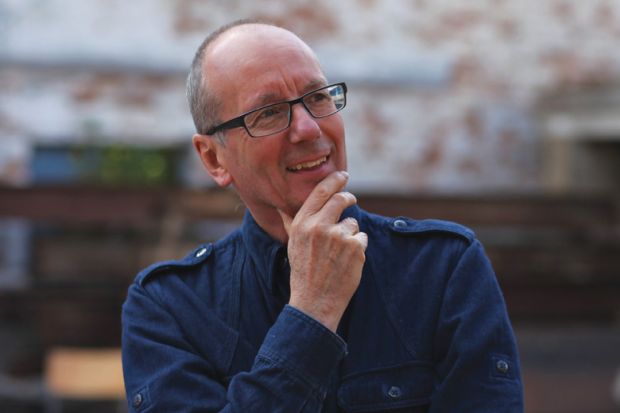Who was your favourite author or book as a child?
Edgar Allan Poe’s Tales of Mystery and Imagination. I was quite young to be absorbing all that disturbing imagery – The Tell-Tale Heart, The Pit and the Pendulum – but the way Poe wrote about hyperacusis, claustrophobia, darkness and weird atmospheres really wormed its way into my imaginative life. The enduring impact of these stories is evident from the choice of title for my new book, Into the Maelstrom, but there was also a lot of Poe soaked into the fibres of my previous book, Sinister Resonance.
Into the Maelstrom includes a quotation from James Joyce’s Finnegans Wake, and you also discuss Dorothy Miller Richardson’s fiction. Is such writing a cousin to the improvisational music you are writing about?
Notions of stream-of-consciousness and spontaneity were established by literature in the 20th century, perhaps more than any other art form. Even Jane Austen hinted at the potential of this territory, back in 1815. Dorothy Richardson’s approach – a flow of text that veers between concrete incidents and free indirect style – in the most inspired passages seems to reach into unspeakable depths and emerge with startling material. Writing is clearly different to performing music, but improvisers, particularly vocalists, also depend on a stream of material to emerge from seemingly nowhere. The risk factor is exacerbated by the audience sitting right in front of you as it happens.
When you were writing Rap Attack: African Jive to New York Hip Hop in 1984 you were told repeatedly that hip hop was finished. Does the genre, or writing on it, still appeal to you?
I still find certain rappers quite interesting, though mostly the tracks I like turn out to be the disreputable, indefensible ones. Bobby Schmurda springs to mind. I’m not that attentive to the music these days, nor do I read much about it, but that’s true of music books in general.
It’s often said that most fiction about music or musicians – especially rock or other popular music – rings false. Have you found any exceptions?
I did reverse that process some years ago by making a record with Jeff Noon, based on his novel Needle In the Groove. There is Gordon Burn’s claustrophobic Alma Cogan and Nik Cohn’s unlovely I Am Still the Greatest Says Johnny Angelo, but beyond that I struggle. Elmore Leonard and George Pelecanos wrote about music appreciation with some conviction. Maybe The Gospel Singer by Harry Crews comes closest, or Where Dead Voices Gather by Nick Tosches, if it were a novel, which perhaps it is. There are great novels about boxers, jet fighter pilots and dental assistants; why musicians should make exceptions of themselves is mysterious. Part of the problem is that music stars are already fictions, yet they live mundane lives: travel, business, rehearsing, practising, alcohol, drugs, sex, hotels, more travel and then brief moments of performance, all of which are forbidding subjects for a writer.
Was Into the Maelstrom harder to write than other books?
It was more difficult to start. Free improvisation is a slippery subject and its historical origins are so fragmented and anecdotal. I’d been thinking about it since the late 1990s, and couldn’t see how to make it work. Finally it was a question of thinking now or never. Writing books seems to get harder – partly the physical effort and sustained intensity, which doesn’t synchronise well with the way your energy changes as you get older, but also the constantly frustrated desire to get better.
What was the last book you gave as a gift, and to whom?
I gave a copy of Clarice Lispector’s Água Viva to my friend Elaine Mitchener. She’s an amazing singer; I knew she would be touched by the book’s intensity and interiority, lines like “I write because I so deeply want to speak. Though writing only gives me the full measure of silence.”
What was the last book by an early career scholar that impressed you?
I don’t feel that “early career scholar” is appropriate to her (let’s say she is very much younger than me and has published fewer books) but I admired and enjoyed Daniela Cascella’s F.M.R.L.: Footnotes, Mirages, Refrains and Leftovers of Writing Sound. She found a new way to think about listening.
What books are you currently reading, or are on your desk waiting to be read?
Speaking of unspeakable depths, the book that I’m planning to read next is The Voices Within: The History and Science of How We Talk To Ourselves by Charles Ferneyhough. It’s about the little understood but universally experienced phenomenon of voice hearing, the stream of thoughts that passes through us in most of our waking moments. Improvising musicians replace those thoughts with sound while writers try to channel their inner thoughts into coherent texts. As I’m both writer and musician it’s a subject I would like to understand more deeply.
David Toop is chair of audio culture and improvisation at London College of Communication and associate lecturer on the BA (Hons) in sound arts and design, University of the Arts London. His latest book is Into the Maelstrom: Music, Improvisation and the Dream of Freedom (Bloomsbury), the first of a two-volume study.
后记
Print headline: Shelf Life
